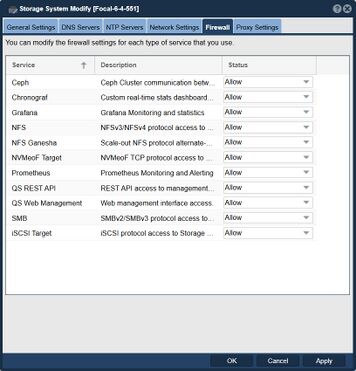Storage System Modify

In QuantaStor, the "Storage System Modify" feature allows administrators to modify and adjust the settings and configurations of a storage system. The purpose of this feature is to provide flexibility and control over various aspects of the storage system to meet specific requirements and optimize its performance and functionality.
Here are some common purposes and functionalities of the "Storage System Modify" feature in QuantaStor:
- System configuration: You can modify general system settings such as the storage system name, description, time zone, and other system-level parameters. This helps in customizing the storage system to match your organizational requirements.
- Network settings: The feature enables you to configure network settings related to the storage system, such as IP addressing, DNS, gateway, and network bonding. This allows you to adjust the network configuration to ensure proper connectivity and optimize network performance.
- User and authentication settings: QuantaStor provides user and authentication management capabilities. With the "Storage System Modify" feature, you can modify user accounts, roles, and permissions, as well as integrate with external authentication systems like LDAP or Active Directory.
- Licensing and feature management: If applicable, you can modify licensing and feature settings within the storage system. This includes activating or deactivating specific features or modules based on your licensing agreements.
- Storage pool and volume configurations: QuantaStor supports various storage configurations such as RAID levels, thin provisioning, snapshots, and replication. With "Storage System Modify," you can modify and fine-tune these settings based on your storage requirements and performance goals.
- Alert and notification settings: You can configure alert thresholds, notification methods, and other settings related to the storage system's alerting capabilities. This helps in effectively monitoring the system and promptly addressing critical events.
- Performance tuning: QuantaStor allows for performance optimization through cache settings, I/O scheduler configuration, and other tuning options. The "Storage System Modify" feature enables you to adjust these settings to enhance the system's overall performance.
You can modify general settings such as the storage system name, DNS servers, NTP servers, and network settings. You can also modify network settings such as grid communication settings, ARP filtering, network bonding policy, and network port naming convention.
Navigation: Storage Management --> Storage Systems --> Storage System --> Modify (toolbar)
![]() Covers QuantaStor 5 Hardware Integration [11:31]
Covers QuantaStor 5 Hardware Integration [11:31]
General Settings

General settings to modify and adjust the storage system settings.
Storage System Name
The name for the storage system is also the network 'hostname' and cannot contain any special characters except the hyphen '-'.
DNS Servers

DNS, Domain Name Server, server settings are configured automatically if you have DNS setup but most appliances are configured with static IP addresses. As such you'll need to add DNS servers to your configuration such as your local DNS server or a public DNS server like Google's at 8.8.8.8.
DNS Domain Suffix & Search Suffix
This is the DNS domain which your QuantaStor appliance is a member of on your network.
NTP Servers

Add or Remove an IP addresses for one or more NTP, Network Time Protocol, servers accessible to the system.
Network Settings

For complex network configurations one may wish to set a preferred grid port to limit Storage Grid communication to a specific network.
Grid Communication Settings
Selects the IP address that QuantaStor will use for all grid management communication with the specified node.
ARP Filtering
ARP. Address Resolution Protocol, Filtering is enabled automatically when you configure network bonding. For more information on ARP filtering please see this informative blog article.
Network Bonding Policy
QuantaStor supports four modes of network bonding. The allowed modes are 'Round Robin', Link Aggregation Control Protocol or 'LACP', Adaptive Transmit Load Balancing, and Adaptive Load Balancing.
LACP has the added benefit that it can bond ports which are connected to separate switches whereas Round Robin mode cannot. LACP also requires configuration settings on your switch for proper configuration and it is recommended that you adjust the flow control settings on your switch to see what produces ideal performance for your hardware and application workloads. For more information on LACP configuration for your hardware please consult your network switch and NIC, Network Interface Controller, documentation.
Network Port Naming Convention
Applies either Predictable (Predictable Network Interface Naming/PNIN) port naming convention (ensN, enoN, enpN) or Unified (ethN) port naming convention. Unified (ethN) based naming is the preferred mode for QuantaStor as it applies a consistent naming across systems which are needed for highly available cluster VIF management.
More information on all of the allowed bonding policies can be found here:
http://www.enterprisenetworkingplanet.com/netsysm/article.php/3697756/Tips-and-Tuning-for-Ethernet-Bonding-With-Linux.htm
Firewall

Adjust the firewall settings for the Storage System.
Proxy Settings

Proxy settings enable the system to communicate with support, licensing, upgrade, and alert servers via the specified proxy server URL(s).